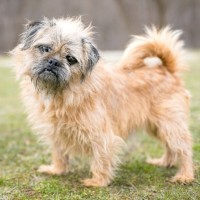Appearance of the Brug
|
| The Brug is an attractive little dog with short, rough-textured or smooth hair. The coat is available in a wide range of colors. The smooth coat is short and straight, has a glossy sheen and lies flat against the skin, while the rough-coated Brug has a longer, dense and stiff coat. The Brug has a sturdy, compact build and a short muzzle somewhere between the flat face of the Griffon Bruxellois and the Pug. They often have the lower jaw of the Pug. With a slightly comical face and often with wrinkles from the Pug parent, the Brug carries itself with dignity. Their heads are round and they have large, round eyes. Their ears are soft and silky. The Brug has short, sturdy legs and either a short, pointed tail or a curved tail. The legs are small and rounded. As a rare breed, the Brug's appearance can vary depending on how much of the parent breed's characteristics it has inherited. But it's not a dog to be ignored or neglected. |
Temperament of the Brug
|
| The Brug is a small dog with a big attitude. Full of his own importance, he is engaging and affectionate, loyal to his owner. The owner must prove he's the leader, or the Brug may take advantage of any weakness, becoming possessive and aggressive. These dogs are playful and inquisitive, take on anything and everyone, and are very outgoing if well socialized when young. Otherwise, the Brug can become emotionally dependent and intolerant of unusual situations or boisterous children. This hybrid responds well to praise and rewards during training, but they have a stubborn streak that can surface. Patience is needed to help you overcome this, as rough handling can damage your dog's sensitive nature. All in all, the Brug is an ideal companion who will offer support when you're down and celebrate with you when things are going well. They love nothing better than to curl up on your lap and absorb all the attention and love you can give them. The Brug is a happy, playful, cheerful and energetic dog. |
Needs and activities of the Brug
|
| Although the Brug is an active indoor dog and can get all the exercise they need from indoor activities, it's always a good idea to take them for a walk. This activity will satisfy their energy needs and stimulate them mentally as they explore new environments. Taking your Brug out for a walk or to play at the dog park is a fantastic way to ensure that your dog is fully socialized with other people and pets. Because the Brug is a small dog with a very big personality, you may need to keep a close eye on his antics as you travel. Their confident bearing and high expectations that everyone will love them, of course, can get them into trouble. They're very playful and will happily join in a game, but you need to be careful that they don't stand up and hurt themselves during physical matches. The Brug likes to explore a well-fenced yard, be it city or country, but its preference is to be with you, wherever you are. |
Maintenance of the Brug
|
| Regardless of coat type, the Brug requires brushing once or twice a week with a firm brush to help remove loose hair. The Brug needs a bath only rarely, but doing so more often will strip the coat of its natural oils and dry out your dog's skin. Rubbing with a soft, damp cloth will soon give the Brug its best appearance. Make sure any folds or wrinkles are thoroughly dried. Combine coat care with an ear check, wiping the ear to maintain good health and remove any build-up of dirt or wax. This is an appropriate time while your dog is relaxing and enjoying the attention, to quietly check his teeth for any plaque build-up or infection. Train your Brug to enjoy a short episode of tooth brushing and showering with praise when they allow you to perform this essential care process. Observe your dog's nails and trim them if necessary. A sure sign that they're growing too long is when they click as you walk. |









 English (United Kingdom)
English (United Kingdom)